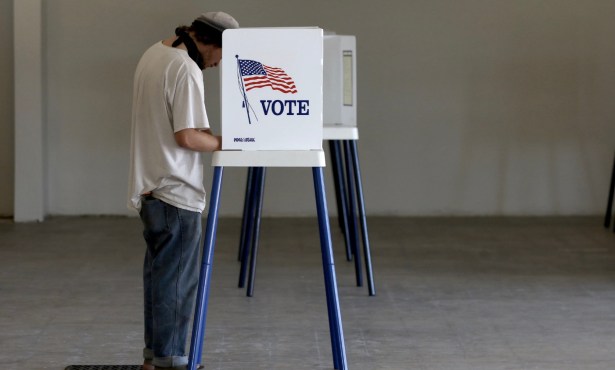It’s a Bird, It’s a Plane, It’s a Dog…
How About More Jobs and Cleaner Air?
DRAWING A LINE IN THE SKY: The good guys clearly won at Tuesday night’s marathon showdown over the biggest oil development project to hit Santa Barbara County in eons. What wasn’t nearly so clear was who the bad guys were. When it was over, I almost felt sorry for Santa Maria Energy, which has made the most convincing case imaginable that it’s not really a big bad oil company at all, but “just folks.” Corporate vice president Beth Marino came across so down-home, so real, and so refreshingly un-slick that I wanted to reach through my TV set and give her a hug. And the company’s logo — which featured an amber sun-infused honeycomb — got my warm-and-fuzzies tingling. But like many an oil company trying to do business in Santa Barbara, Santa Maria Energy found itself undone by fatally bad timing.

First, it should be noted that nobody is stopping Santa Maria Energy from pumping up to 3,000 barrels of oil a day out of the 110 new oil wells it’s gotten approval to sink on an already industrialized patch of land near Orcutt. It can and it will. (For details, read Lyz Hoffman’s news article on page 10.) The only dispute was how much air pollution — specifically greenhouse gases — the project should be allowed to emit without doing anything about it. The project will generate about 87,000 metric tons of such gases a year. That’s a lot. Santa Maria Energy is proposing to mitigate and to offset about 25,000 tons worth. It should be noted that’s twice as much as the company is legally required to under California’s 2006 climate-change law AB 32. But the glass-is-half-empty crowd was hardly impressed, pointing out that the proposed project would have the same effect on the county’s air as 17,000 additional cars on the road. Led by the Environmental Defense Center, a coalition of environmental groups insisted that Santa Maria Energy had to do more. They pointed out that the county’s line-in-the-sand threshold for greenhouse gas emissions has traditionally been 10,000 metric tons a year. That’s not just what Santa Barbara has used, they noted; it’s what San Luis Obispo County and the Bay Area air pollution control district have insisted upon, as well.
Not since Venoco put its ill-fated oil initiative on the Carpinteria ballot a month before the BP oil disaster exploded in the Gulf of Mexico a few years ago has any oil company been afflicted with such disastrous timing as Santa Maria Energy. There probably is no “good” time to seek special dispensation to dump 62,000 metric tons of greenhouse gases into our air basin. But now is about the worst. Greenhouse gases don’t make people cough and wheeze as do pollutants like diesel particulates or ozone precursors; instead they fuel climate rage, euphemistically referred to these days as “climate change.” The wholesale violence just inflicted by Über Storm Haiyan on the people of the Philippines makes it a whole lot harder to pretend climate change is some hoax perpetrated by the Chicken Littles and eco-hysterics out there. It’s true the Philippines have always served as the trailer park of the South Pacific, constantly getting laid to waste by one typhoon or another. But this one is bigger and faster — with speeds clocking in as fast as 230 miles an hour — than anything in recorded history. As the oceans absorb more heat, the meteorologists tell us, the frequency and ferocity of such storms will only increase. The biggest reason an engaging slob like New Jersey’s Governor Chris Christie is considered presidential material is his heroic response to last year’s Hurricane Sandy — yet another celebrity über storm. Yes, nature has always been prone to volatile mood swings. But now it’s positively bipolar and very much off its meds.
Nor did it help Santa Maria Energy’s case that the hundreds of scientists making up the United Nations’ Intergovernmental Panel on Climate Change just released yet another report detailing how dire the situation has grown. Since the 1880s, the planet’s temperature has risen about 1.5 degrees because there’s more greenhouse gas in the atmosphere than any time in the past 800,000 years. If the global thermometer rises by 2.7-8.1 degrees, we’re looking at a sea-level rise of 10-32 inches. Since 2011, the United States has experienced 25 extreme weather events that cost $1 billion or more each. The drought in Russia wiped out one-quarter of its 2012 grain harvest. And according to a think tank commissioned by the German government, extreme weather killed 530,000 people worldwide last year.
Supervisor Steve Lavagnino’s passionate soliloquy on behalf of Santa Maria — so desperate, so eloquent, so raw — was undeniably one of the most compelling speeches I’ve ever seen in the supervisors’ chambers. But when I heard it will only cost the company an extra 60 cents a barrel to reduce its greenhouse gas emissions down to the 10,000-ton threshold, I suddenly became a lot less mesmerized. The total price tag tossed around at the supervisors’ meeting was half-a-million bucks a year. That sounds like a big number. But not nearly as big as the $110 million a year in revenues that Santa Maria Energy could generate at maximum production so long as oil sells for $100 a barrel.
When the vote finally came down to require Santa Maria Energy to do more, I still wanted to give Beth Marino a hug. She seemed like a nice person. Her project can still go forward, creating much-needed jobs and generating much-needed tax revenues. But sadly, climate change is not a figment of anybody’s imagination. To give Santa Maria Energy a pollution break in this context would have been insanity and would have set an insane precedent for subsequent energy proposals. The supervisors needed to draw a line in the sand by drawing a line in the sky. Like I say, there were no bad guys. Maybe there were no good guys either. Maybe this once, we all won.



